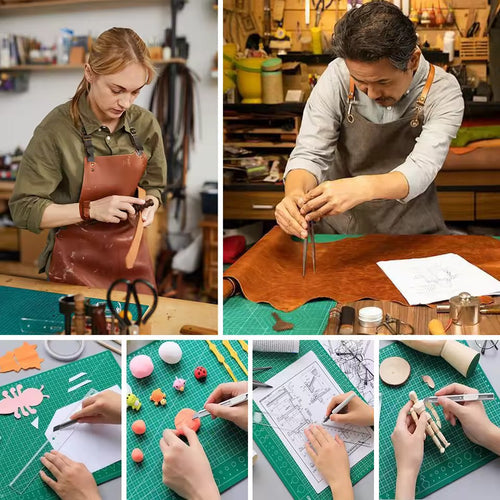Quilting is a timeless craft that allows creators to express their artistry through fabric and thread. But when it comes to choosing the right technique, it can be challenging to decide between machine quilting and hand quilting. Both methods have their own advantages, and they cater to different project needs. With quilting growing in popularity, quilters often find themselves asking, "Which technique is right for me?"
Are you stuck deciding between machine quilting or hand quilting? Let’s explore the pros and cons of each to help you choose the best method for your next quilting project.
Part 1: Understanding Machine Quilting
What is Machine Quilting?
Machine quilting involves using a sewing machine, or sometimes a specialized longarm quilting machine, to stitch the quilt layers together. This technique allows for precise stitching with minimal effort, using pre-set patterns or free-motion stitching. It's commonly used for large quilts and is popular for its speed and consistency.
Advantages of Machine Quilting
Speed: Machine quilting helps you complete your quilt projects much faster, making it ideal for those looking to produce multiple quilts or large projects in a shorter time.
Consistency: With a machine, you get even and consistent stitches, particularly important for large quilts or intricate designs.
Automation: Many quilting machines have built-in patterns, reducing the need for manual labor. This makes machine quilting more efficient, especially for repetitive designs.
Efficiency for Large Quilts: Machine quilting is particularly useful for large quilts or mass production, where the size makes hand quilting impractical.
Disadvantages of Machine Quilting
Less Personal: While efficient, machine quilting lacks the tactile, handmade feel of hand quilting. It can feel less "personal" because it’s not directly stitched by hand.
Learning Curve: For beginners, using a machine can be tricky, especially if you're unfamiliar with different quilting techniques or machine settings.
Less Tactile Feel: Machine quilting may not have the same warmth or charm as hand quilting, especially if you're creating heirloom quilts.
Best Projects for Machine Quilting
Machine quilting is perfect for large quilts and intricate patterns where precision is important. It’s also ideal for projects requiring speed and consistency, such as mass production of quilts or projects made for gifting.
Cost of Machine Quilting
Machine quilting can be costly if you're purchasing a high-quality sewing or quilting machine. However, outsourcing to professional quilters can be more affordable than buying your own equipment, especially if you don’t plan on quilting regularly.
Part 2: Exploring Hand Quilting
What is Hand Quilting?
Hand quilting involves stitching through the layers of a quilt with a needle and thread, creating a unique, handcrafted design. This technique allows quilters to work at their own pace, making it perfect for those who enjoy the meditative and creative process.
Advantages of Hand Quilting
Personal Touch: Hand quilting offers a deeply personal touch. The process is slow and methodical, resulting in one-of-a-kind quilts.
Unique Finish: Since every stitch is done by hand, it adds an individual charm and character to each project.
Minimal Equipment: Hand quilting requires very little in terms of tools. A needle, thread, and thimble are enough to start, making it accessible for all.
Disadvantages of Hand Quilting
Time Consuming: Hand quilting takes considerably longer than machine quilting. The process can be slow, especially for large quilts.
Physically Demanding: It can be physically demanding, particularly when working on large quilts that require hours of stitching.
Not Ideal for Large Projects: Hand quilting can be difficult for large quilts, as handling such a large piece can be unwieldy without assistance.
Best Projects for Hand Quilting
Hand quilting is ideal for small to medium-sized quilts. It’s perfect for those who are creating heirloom quilts or those seeking a traditional, personal finish. Hand quilting adds charm to any project, especially those where attention to detail is important.
Cost of Hand Quilting
Hand quilting requires minimal investment for tools, making it a more affordable choice for those just starting out. However, due to the time and labor involved, hiring professionals to hand quilt a project can be more expensive than machine quilting services.
Comparing Machine Quilting and Hand Quilting
Time: Machine quilting is faster than hand quilting, especially for large quilts.
Cost: Machine quilting has higher upfront costs for equipment, but it is more efficient. Hand quilting involves lower startup costs but may be more expensive due to time and labor involved.
Aesthetic: Hand quilting gives a more traditional, textured finish. It offers a unique, handcrafted look that machine quilting can’t quite replicate. In contrast, machine quilting offers a sleek, modern finish, perfect for those seeking consistency and precision.
Skill Level: Machine quilting is more accessible for beginners, as machines do a lot of the work for you. Hand quilting requires practice and patience to master, especially when creating intricate designs.
Which Quilting Technique is Right for You?
When deciding between machine quilting and hand quilting, consider the following factors:
-
Project Size: For larger quilts, machine quilting is the way to go due to its efficiency and speed. Hand quilting is best for smaller projects or those requiring intricate details.
-
Time Constraints: If you’re on a tight deadline, machine quilting will save you time. Hand quilting requires a more considerable investment of time and effort.
-
Desired Finish: Do you prefer a polished, modern look, or do you want a unique, personal finish with a traditional feel? Machine quilting offers a more uniform and contemporary appearance, while hand quilting delivers a rustic, handmade aesthetic.
-
Skill Level: If you're a beginner, machine quilting might be easier to start with. Hand quilting, however, can be learned with practice and patience.
At HandMade Keeps, we offer a variety of quilting tools like Patchwork Rotary Cutters, Quilters Cutting Mats, 5 In 1 Quilt Cutting Templates, and a Free Gift Offer with our Quilt Cutting Templates to support both hand and machine quilting projects. Choose what works best for you, and enjoy the creative process!
FAQs
Q1: Is machine quilting faster than hand quilting?
Yes, machine quilting is significantly faster, especially for large quilts.
Q2: Can a beginner do hand quilting?
Yes, beginners can try hand quilting, but it requires practice.
Q3: Does machine quilting cost more than hand quilting?
Machine quilting involves higher upfront costs for equipment, but it’s more efficient. Hand quilting may be less expensive in terms of equipment but requires more labor and time.
Q4: Is machine quilting as durable as hand quilting?
Yes, both methods create durable quilts. However, hand quilting offers a more personal and unique finish, while machine quilting is also sturdy and reliable for large projects.
Conclusion
Choosing between machine quilting and hand quilting depends on your project, timeline, and desired finish. Consider the size of your quilt, your skill level, and the look you want to achieve. Whether you opt for the speed and precision of machine quilting or the personal touch of hand quilting, both techniques offer something special. Let your creativity shine through and enjoy every stitch of the process!




